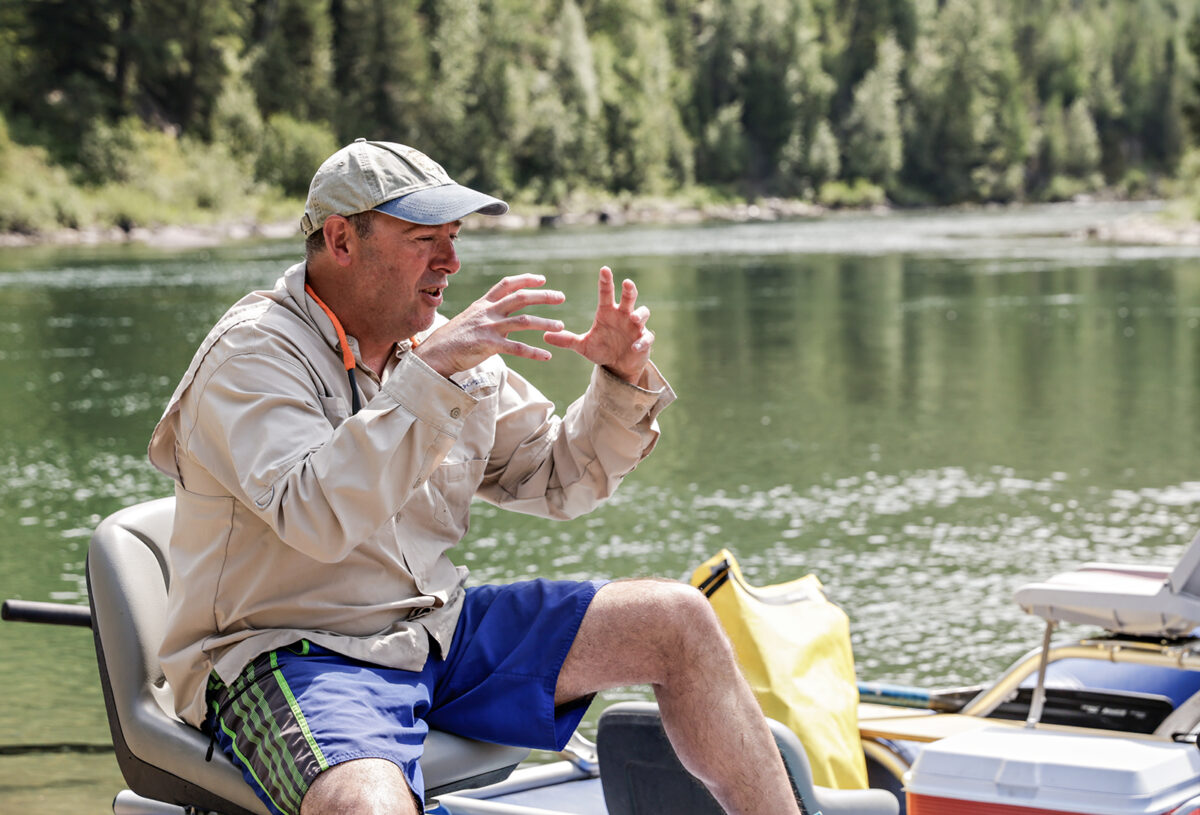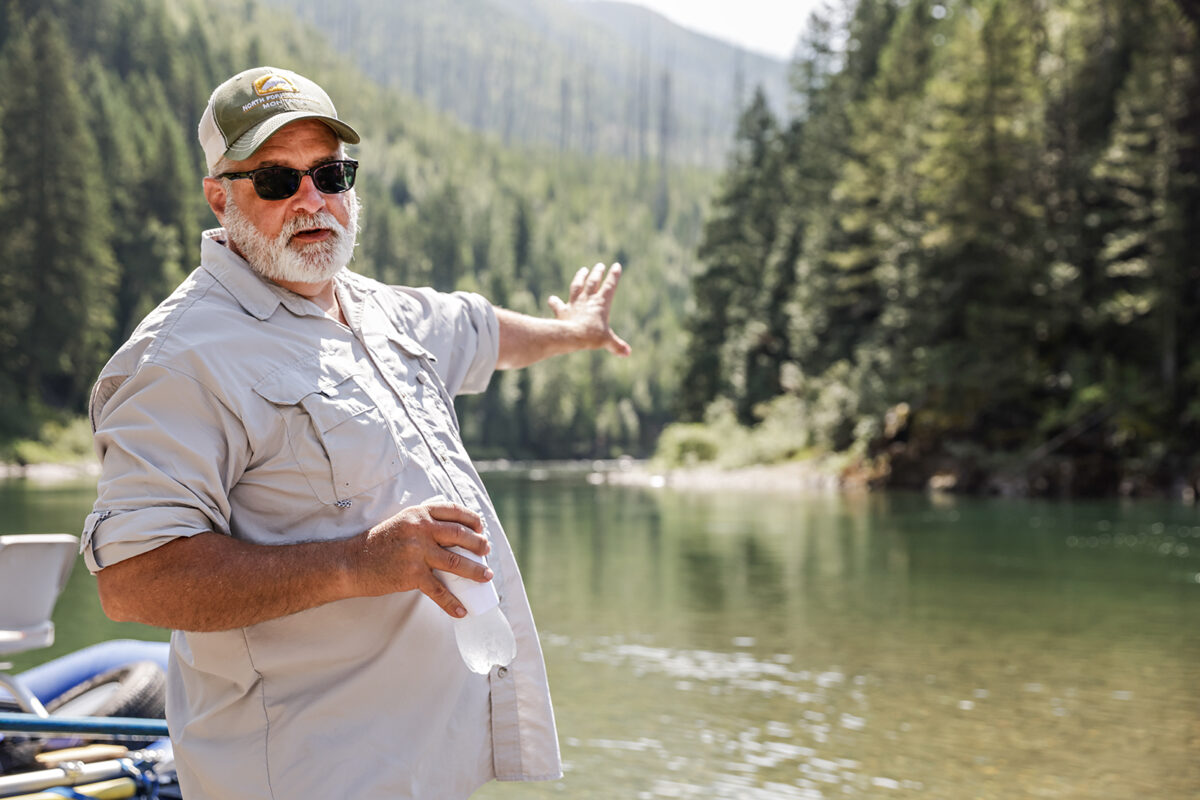Angler Pressure, Data Gaps and Rising Water Temperatures Present Management Challenges on Flathead River
Fisheries biologists say high temperatures and increased pressure on the three forks of the Flathead River brings stress to native fish, but an absence of angler surveys means agencies are lacking data that connects fishing to population estimates
By Maggie Dresser
As recreational use on the three forks of the Flathead River continues to increase pressure on the waterway system, fisheries specialists are finding higher stress levels on the region’s native fish, but a lack of angler data presents river management challenges for government agencies.
Fisheries biologists, conservationists and stakeholders gathered on Aug. 5 for the annual Flathead Rivers Alliance partner float on the North Fork where officials shared the latest updates on the interagency Comprehensive River Management Plan (CRMP).
Following staffing shortages and pandemic-related delays, officials with Glacier National Park (GNP) and Flathead National Forest (FNF) are moving forward with the plan and the environmental assessment will be released in the fall of 2024. Once the draft plan is available for public review, agency officials will initiate the environmental analysis under the National Environmental Policy Act (NEPA), which will include opportunities for public involvement and comment.
Park and forest biologists along with Montana Fish, Wildlife, and Parks (FWP) officials highlighted how increased river use impacts fish populations and said a lack of angling data presents challenges when determining the best management practices.
Leo Rosenthal, a fisheries biologist with FWP, says westslope cutthroat trout population estimates on the South Fork near Black Bear Bridge in the Bob Marshall Wilderness reveal a flat population density that has hovered around 600 fish per mile over the past 25 years.
But while the population estimates are relatively unchanged, Rosenthal said larger fish that are about 12 inches have declined, possibly due to increased handling.
“What we see over time is those numbers of larger fish have declined in the three forks of the Flathead and some of that is they are getting harder and harder to mark,” Rosenthal said. “There’s more people out on the river fishing for them and if these fish are caught, there’s a good chance they are not going to eat again that day.”
But if fish populations decline, Rosenthal said FWP could issue more restrictive actions like shortening the fishing season. In 2020, the agency restricted single-point hooks to mitigate stress on fish, but regulations are often difficult to enforce.
During a recent summer heat wave on July 24, fisheries managers imposed “hoot owl” restrictions, which prohibits fishing from 2 p.m. to midnight to protect fish from further stress, after the North Fork exceeded 66 degrees Fahrenheit for three consecutive days. The restrictions were lifted on Aug. 7.

Chris Downs, the Aquatics and Physical Science Programs Leader for GNP, says the warming climate has presented a range of management challenges as he’s encountered significantly higher temperatures on the North and Middle forks in recent years.
“Climate is a different issue,” Downs said. “We look at vital signs of the park and that temperature shows up red and that’s what we’re seeing at the [Canadian] border. We’re seeing significant increases in water temperature, and we’ve actually seen the biological community change up there to where it’s more tolerant of the water.”
In recent years, as the pandemic brought an influx of new residents to the Flathead Valley, officials say it’s added more private recreational pressure on the three forks. But without an angler survey, agencies lack data to support anecdotal evidence of increased congestion on the river system, which presents management challenges.
“One of the biggest missing pieces is we know anecdotally that there’s a lot more angler use out there than there used to be, but we don’t know how much more angler use there is because that comes from an anglers survey,” Rosenthal said.
While FWP manages things like fishing restrictions, FNF officials are tasked with controlling how many users are on the river because access sites are typically on national forest land.

Craig Kendall, the FNF watershed and fisheries program manager, says without angler data, it’s impossible to know how many river users are fishing.
In addition to the CRMP, the Forest Service is also working on a planning effort that involves the renewal of 62 outfitter guide permits in the Bob Marshall Wilderness where trips are guided on the Middle and South forks.
“Right now, it’s a really important time for fisheries because we’re trying to get a handle on how much angling is taking place through the outfitters — how much is going on now, and how much we anticipate through the period of this river management plan, which is through the next 30 years at least,” Kendall said. “Given the sensitivity of this fishery — because of the water chemistry — native fish population densities are pretty low. As fishing pressure goes up, we do have concerns about the long-term sustainability of this fishery.”
While most anglers are fishing for westslope cutthroat trout, biologists are also concerned about bull trout populations. Bull trout fishing is prohibited on the North and Middle forks but is allowed on limited areas on the South Fork.
As river use continues to increase pressure on the three forks, officials say there is minimal conflict between commercial outfitters and private boaters compared to areas like southwest Montana. But officials attribute most conflict to a saturation of local recreationists.
“There’s just a lot of people on the river and we don’t want to see it get degraded,” Kendall said.
After years of delays, park and forest officials this spring selected Mary Greenwood, who joins the local planning effort from the U.S. Forest Service’s Wilderness, Wild and Scenic Rivers Program in Washington, D.C., to help steer the CRMP planning process.
Managers with the FNF and GNP began work on the lengthy CRMP process in 2018 and, in July 2019, released a proposed action plan for the three forks of the Flathead River — the North, South and Middle forks, which all received federal designations in 1976 under the Wild and Scenic River Act. The last management plan was adopted in 1980.
The Wild and Scenic Rivers System has three classifications: wild, scenic and recreational, which each exist on various river reaches on the three forks of the Flathead.
Officials use “indicators,” “triggers” and “thresholds” to prompt management actions including permitting and limiting sizes of float groups and restricting outfitters.
More information on the Flathead Wild & Scenic River Comprehensive River Management Plan can be found at: http://www.fs.usda.gov/goto/flathead/crmp.

